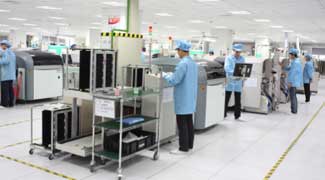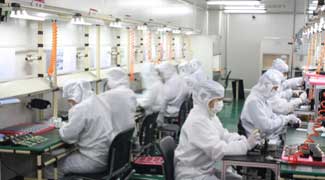Hikvision is starting to gain global recognition amongst worldwide buyers. R&D and quality control has laid the foundation for Hikvision’s accomplishment. a&s talked to the company for more in-depth understanding toward their internal management.
While China is quickly taking up the position as the worldwide manufacturing hub, the stereotypical image of “made-in-China” still made global buyers hesitant about working closely with some Chinese companies. However, based on the latest 2013 survey on worldwide major professional security buyers by a&s, Chinese products are ready to prove their worth with improved quality and service, which provides a major boost for all Chinese manufacturers. From our recent interviews with those buyers, Hikvision Digital Technology was the Chinese company that was mentioned most often, winning the highest satisfaction and recognition.
Global Recognition
Hikvision, originally renowned for its DVRs, has now become a total solutions provider in video surveillance. In the recent world market report for CCTV and video surveillance equipment from IMS research (an IHS company), Hikvision was ranked as the number one supplier under the category of “CCTV and Video Surveillance Equipment,” with 8-percent market share in 2012. In the category of “Security Cameras,” Hikvision was also ranked third with a 9.7-percent world market share, while maintaining first place in “DVR suppliers” for four consecutive years in 2012.
Hikvision's success wasn't achieved overnight. Yangzhong Hu, President of Hikvision, still remembers the many hardships the company went through to launch its first auto-focus camera module in early 2000, marking a major technology milestone for the company. Since then, Hikvision's sales revenue in surveillance cameras has started to double and even triple, and the company gradually became an actual total solutions provider in video surveillance.

Core Competitiveness
Positioning itself in the middle- to high-end market sectors, Keen Yao, International Marketing Director said “Hikvision's main competitiveness are product innovation and cost optimization, which support Hikvision in providing quality products plus a reasonable price. Both factors also make the company achieve good gross margin continuously since establishment.”
The cost optimization, Yao added, is achieved by the company's increasing production scale. “By keeping innovating in products and expanding production lines, complete from front end to back end devices, the overall cost of production and purchasing can be well controlled.”
Hikvision has been dedicated to security industry for over 12 years. Its thorough understanding of the industry and continuous R&D investment help the company maintain product innovation and technology leadership in global security market.
R&D Investment
Several major factors contributing to Hikvision's success are its previous OEM experience with some well-known global companies, which pushed Hikvision to strengthen its product development capability, as well as strictly focus on its quality control and production process. The company's high penetration in its domestic market provides Hikvision with a clear direction of product innovation.
Over these years, Hikvision's R&D, and quality and process control have achieved international standards.
CMMI Certified Management
In 2009, Hikvision started to work with some consulting firms to enhance its internal efficiency of R&D, quality control, and production. Since then, the company has introduced Capability Maturity Model Integration (CMMI) to greatly improve its process management of product research and development. CMMI is a process improvement training and certification program and service administered and marketed by the Software Engineering Institute (SEI) at Carnegie Mellon University. With them, “we are able to have a set of unified protocols to well manage different departments and have the same language to conduct cross-department communication,” said Junke Chen, R&D Director.
R&D Matrix Project Management
To optimize new product development and maintain technological leadership, Hikvision employs a matrix management structure for its R&D department, which allows them to succeed in cross-department project cooperation between its resource teams and product teams. Hikvision's product teams are categorized by its product lines, including DVR/NVR, network cameras, analog cameras, vertical-specific VMS and others while the resource team is divided by several key technologies – hardware, image processing, video/audio codec, compression, networking, streaming media, FPGA applications, video data storage, embedded applications, software structure and others. At Hikvision, a specialized project team, from groups of resource teams and the corresponding product teams, is usually formed to develop a new product. This means each group of resource teams has to be responsible for several product development projects and must be able to work on multiple projects simultaneously.
It is worth mentioning that software is the core value of Hikvision product development. “Although we sold mostly hardware, software is the key inside hardware. Hikvision has a powerful software capability. A large amount of work is on the software side, even in hardware manufacturing,” said Yao.
Market-Oriented Product Development
What is worth mentioning is that Hikvision's R&D team also has to meet the sales target, along with sales team. “The product should be market-oriented and clearly meet the needs for the customers. The KPI for each product line is to meet certain sales targets. R&D also takes the responsibility if their products don't meet the real market demand,” said Chen.
Product Usability
Product usability requirements are quite high in overseas markets. Many Chinese products are usually weak in this part. This year, Hikvision put a lot of R&D resources in product user interface, client software, and mobile APP to elevate the ease of use in its products. Hikvision also started to outsource the language-related design and the external design of its latest network cameras, including aesthetic outlook and internal software design, two or three years ago. The product usability of Hikvision's products now is greatly improved.
Supply Chain Collaboration
Hikvision also follows the “integrated supply chain” concept, proposed by Huawei Technologies. The supply chain includes suppliers (manufacturing partners), Hikvision (the company), and Hikvision's clients. Tim Zhang, Quality Manager said “We invite all these parties together for joint product evaluation and collaboration, advised by our consulting company. We also ask our suppliers to join our product development. They provide suggestions on how to make those products meet international standards and how to optimize the structure/system.”
Quality Control
Hikvision has developed a comprehensive and strict management system in process. In Hikvision, the quality control department is independent from R&D and production department. These three departments are positioned equally to complement and evaluate each other.
Quality control, a complete system from R&D design, manufacturing to service, is categorized into reliability verification, test, process control, productivities, and after-sales service. “Under each item, we have a specific objective and indicators to measure the outcome,” said Zhang. With this system, Hikvision is able to provide further assurance for customers -- Design Quality Assurance (DQA) and Manufacturing Quality Assurance (MQA).


Design Quality Assurance
DQA is under the R&D product testing department mainly for product reliability verification. Hikvision has more than 2,000 people on their R&D team--the largest in the security sector. Around 350 engineers on the R&D team, which accounts for over 15 percent of the team, are responsible for product testing. The product testing group is in charge of software tests, hardware tests, and reliability tests, which all play an important role in product development and guaranteeing product quality. The tests include anti-interference, anti-radiation, extreme temperature, vibration, drop, water-proof, electrostatic surge and electrocution prevention, salt spray, and anti-wind/dust tests, etc.
The product testing group conducts tests in many different testing laboratories, such as a 960-square-meter (10,333 square feet) stability and pressure testing laboratory, two image quality testing rooms, and a large laboratory for integration, monitoring, and management systems testing. In total, all of the laboratories combined occupy 1,300 square meters (13,993 square feet).
Manufacturing Quality Assurance MQA is divided into four categories: raw materials quality control, productive process, tests, and outgoing quality control.
Boasting over 100,000 square meters (1.1 million square feet) of manufacturing space, Hikvision's production facilities are underpinned by state-of-the-art manufacturing equipment and resources. As an example of this point, in 2011, Hikvision introduced Siemens' fully-automatic SMT equipment for production lines, ensuring world-class technical capability.
Hikvision also has dual dustless workshops for precise component assembly of camera lenses. Occupying 800 square meters (8,611 square feet), the workshops measure up to the highest cleaning standard - a class of 100,000.
In addition, to ensure high product quality, all the products need to pass the high-temperature aging test and the company also developed foolproof equipment, such as auto focus tester and auto testing software, to efficiently reduce human errors and poor visibility during production.
SAP System for High Production Efficiency
To meet its huge sales volume target, Hikvision purchased a SAP system from Germany to avoid any problems in materials preparation cycles which may lead to downtime of the production line. With the barcode, the whole production and quality control process can be traced: each machine can be analyzed for the specific time for production, and identification of every supplier and operator. “With the SAP system, we can efficiently optimize material management to achieve low inventory and turnover rate with guaranteed quality,” continued Zhang.
International Marketing Strategy and Customer Service
In addition to its technological and quality improvements, Hikvision is also focusing on providing local after-sales support to ensure better services for its partners. International buyers have expressed concern about Chinese products--one of the reasons is product quality--particularly about Chinese manufacturers being unable to provide efficient service and support to address problems. Therefore, the most crucial part of service localization is to implement better commitment to customers.
“With 12 regional branch offices in other parts of the world, Hikvision has devoted itself to offering customers in-depth local services via thorough maintenance, an after-sales service system, a complete customer complaint handling process, and a professional training program,” said Yao.
With the efforts and improvements of these past years, Hikvision has successfully transformed and became a trustworthy and quality-guaranteed solutions provider. Hikvision has shaped the new image of Chinese manufacturers and the company's future development in the global market can be highly anticipated.